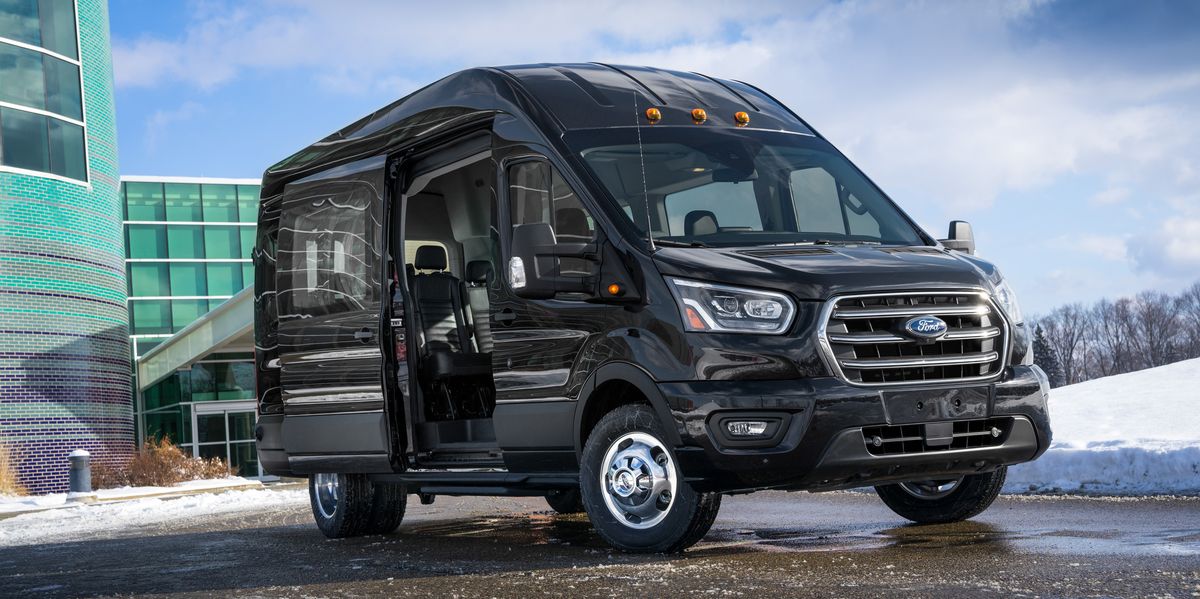2022 Ford Transit

Overview
When it comes to full-size vans, the 2022 Ford Transit possesses the most desirable skill set. As with the Ford’s main competition—namely the Mercedes-Benz Sprinter and Ram ProMaster—it’s highly configurable and very capable. Along with different roof heights and multiple wheelbases to choose from, the Transit is available in cargo, crew, and passenger variations. Power comes from either a 275-hp V-6 or a 310-hp twin-turbo V-6. Both pair with a 10-speed automatic and rear-wheel drive, but the turbocharged engine alone is compatible with all-wheel drive. Need to pull a trailer? The 2022 Transit can lug up to 7500 pounds, and every model comes with a bevy of standard driver assists. Arguably its best traits are how well the big van handles and how quiet its cabin is.
What’s New for 2022?
For 2022, Ford doesn’t make any significant changes to the vast lineup of Transit vans. They’re still offered with multiple configurations, two different powertrains that pair with a 10-speed automatic transmission, and both rear- or all-wheel drive.
Pricing and Which One to Buy
The base-model Ford Transit cargo van T-150 that comes with a generous selection of standard features is our pick of the range. This van rides on 16-inch steel wheels, and it comes with exterior features such as power-adjustable sideview mirrors and a split swing-out rear door for easy cargo access. A four-way adjustable driver’s seat and a manually adjustable tilt-and-telescoping steering column are on hand to help you get comfy behind the wheel. The list of standard equipment includes amenities such as Bluetooth connectivity, dual USB ports, and air conditioning. Additionally, all Ford Transit vans come with driver-assistance features such as lane-keeping assistance and lane-departure warning. We’d include the optional blind-spot monitoring for safer lane changes.
Engine, Transmission, and Performance
Ford’s Transit is offered with two powertrains. The base engine is a naturally aspirated 3.5-liter V-6 that provides 275 horsepower and 262 pound-feet of torque. There’s also a turbocharged 3.5-liter V-6 available that generates 310 horsepower and 410 pound-feet of torque. Both engines are paired with a 10-speed automatic transmission, and buyers can choose between rear-wheel drive and all-wheel drive. The Transit can tow up to 7500 pounds. The Mercedes Sprinter offers more robust payload capabilities. A Transit with the turbocharged V-6 that we tested made it to 60 mph in 6.8 seconds. That makes it quicker than a Nissan NV that we tested; that van completed the sprint in 7.5 seconds. The Transit’s suspension is tuned to deliver a forgiving ride quality that you’ll appreciate during daily commutes.
Fuel Economy and Real-World MPG
Full-size vans such as the Transit are exempt from federal fuel-economy standards. As a result, this van hasn’t been tested by the EPA. As is the case with many full-size vans, the Transit isn’t exactly a leader in fuel efficiency. On our 75-mph highway fuel-economy route, which is part of our extensive testing regimen, the Transit with the turbocharged V-6 logged 17 mpg. For more information about the Transit’s fuel economy, visit the EPA’s website.
Interior, Comfort, and Cargo
Ford offers the Transit with a variety of roof heights and wheelbase lengths, and this allows you to tailor the cabin size to fit your needs. The Transit passenger wagon seats up to 15 passengers. The van’s cabin design is slick and contemporary, taking cues from the Ford Explorer. The Transit’s interior is quiet at highway speeds, shielding passengers from road noise.
Infotainment and Connectivity
The base Transit is equipped with features such as a four-speaker sound system, Bluetooth phone and music streaming, and a 4.0-inch multi-function display. All models come with a Wi-Fi hotspot that allows your passengers to enjoy easy connectivity. The options list includes an 8.0-inch display screen, integrated navigation, Sirius XM satellite radio, and Android Auto/Apple CarPlay smartphone integration.
Safety and Driver-Assistance Features
Ford has equipped this van with plenty of standard driver-assistance features that can help to prevent accidents. For more information about the Transit’s crash-test results, visit the National Highway Traffic Safety Administration (NHTSA) and Insurance Institute for Highway Safety (IIHS) websites. Key safety features include:
Standard forward-collision warning with automated emergency braking Standard lane-keeping assistance and lane-departure warning Available adaptive cruise control
Warranty and Maintenance Coverage
The Transit provides adequate warranty protection. Still, you’ll get longer coverage with the Nissan NV and its five-year/100,000-mile bumper-to-bumper warranty.
Limited warranty covers three years or 36,000 miles Powertrain warranty covers five years or 60,000 miles No complimentary scheduled maintenance
Specifications
VEHICLE TYPE: front-engine, rear-wheel-drive, 2-passenger, 2-door van
PRICE AS TESTED: $45,670 (base price: $38,900)
ENGINE TYPE: twin-turbocharged and intercooled 24-valve DOHC V-6, aluminum block and heads, direct fuel injection
Displacement: 213 cu in, 3497 cc
Power: 310 hp @ 5500 rpm
Torque: 400 lb-ft @ 2500 rpm
TRANSMISSION: 6-speed automatic with manual shifting mode
DIMENSIONS:
Wheelbase: 147.6 in
Length: 235.5 in
Width: 81.3 in Height: 100.7 in
Passenger volume: 84 cu ft
Cargo volume: 357 cu ft
Curb weight: 5423 lb
C/D TEST RESULTS:
Zero to 60 mph: 6.8 sec
Zero to 90 mph: 15.3 sec
Rolling start, 5-60 mph: 7.1 sec
Top gear, 30-50 mph: 3.8 sec
Top gear, 50-70 mph: 4.8 sec
Standing ¼-mile: 15.3 @ 90 mph
Top speed (governor limited): 97 mph
Braking, 70-0 mph: 171 ft
Roadholding, 300-ft-dia skidpad*: 0.60 g
FUEL ECONOMY:
C/D observed: 14 mpg
C/D observed 75-mph highway driving: 17 mpg
C/D observed highway range: 420 mi
*stability-control-inhibited
More Features and Specs







